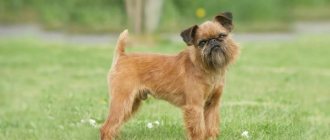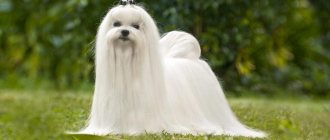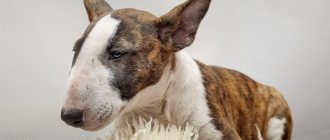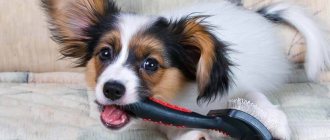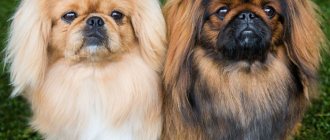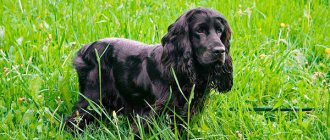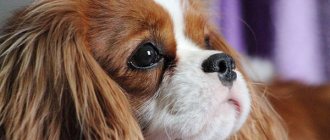Giant Schnauzer
Large Schnauzer - height at withers up to 70 cm. The breed is considered universal, as it combines the qualities of a watchman, security guard, shepherd and companion. He is suspicious of strangers, but constantly tests his own people for strength, showing that he is not ready to unconditionally obey any imposed rules. The Giant Schnauzer is a powerful dog, prone to dominance, which only an experienced owner can handle.
In addition to his complex character, he has incredible strength and energy that needs an outlet. Loitering at home can end disastrously for furniture and interior design. It is best to start the breed in a private home and devote maximum free time to the dog: Giant Schnauzers need long walks and training. The breed is often used in search and conservation work.
Belgian Griffon
Small, playful dogs with a slightly curved forehead, short muzzle and wide skull were bred in Belgium around 1800. Griffons are great companions that require constant mental and physical stimulation. They are somewhat stubborn and picky and cannot tolerate small children of any age. Some males have an increased appetite, so carefully monitor their diet and do not leave food freely available. Clean your thick mustache and drooping beard daily from food debris and any dirt, and comb it. Periodically trim any excess hair that gets into the corners of your eyes to avoid irritation. The optimal number of walks per day is 2-3. After going outside, be sure to wash your paws and undercoat with a special shampoo.
Belgian griffin
Bearded Collie
In addition to the goatee, he has a luxurious mustache, which also requires care. Like all collies, it is a herding breed. This is a fairly large dog, growing up to 56 cm at the withers. By nature she is calm, balanced, non-aggressive. Not suitable for the role of a watchman or security guard due to his sociable and cheerful character. He gets along well with children and quickly becomes attached to his family. Due to increased activity, it is best to keep it in a private house or in a spacious apartment near a park, where you can run around to your heart's content.
Dog breeds
There are more than 500 dog breeds in the world, and new ones appear every year. The selection from Lapkins.ru presents all dog breeds with names and photographs in alphabetical order. The list will be useful not only for those who want to know the name of a certain breed, but also for those who are seriously thinking about which dog to buy. Read descriptions of the breeds you like, learn about their main characteristics, history, features of education and care, diseases, tips for choosing a puppy, watch photos and videos of typical representatives. To make it easier to compare breeds with each other, use the filter. By making a choice with both your heart and mind, you will gain a furry friend for many years that suits your temperament and living conditions.
Dogs are the most popular pets. Only cats can compete with them. Dogs have lived next to humans for centuries, never tired of proving their devotion and love to him. The whole variety of breeds can be divided into indigenous ones - those that appeared through natural selection, and cultivated ones - bred by breeders. Native species are quite independent, capable of making independent decisions, and are not very trainable, while breeds that were created specifically are more human-oriented and prone to learning quickly. Depending on what kind of work a dog is capable of performing, there are service, hunting, guard, fighting, herding, and decorative breeds. It is difficult to overestimate the help of these animals to people, especially since many of them become faithful companions, ready to sacrifice themselves for the sake of their owner. And humanity knows how to be grateful: films are made about dogs, books are dedicated to them and monuments are erected. A striking example was the film “Hachiko: The Most Faithful Friend,” based on the true story of an Akita Inu dog. The melodrama inspired millions of people - after watching, probably everyone wanted to have a similar dog.
Dog connoisseurs can consider Russian, Japanese, German, English, American, Chinese and French breeds as a cultural heritage of different countries.
All dog breeds can be classified by size. Traditionally, breeds are divided into small, medium and large. At the same time, the group of small pets includes toys, dwarf and small breeds, and large dogs include large and giant individuals. Size is one of the main criteria for whether a dog is suitable for an apartment. But not the only one: the pet’s character is no less important.
In the catalog of breeds you can choose dogs that have certain qualities: smart, calm, kind, evil, dangerous. Lovers of silence will appreciate non-barking breeds. Although external attractiveness is a subjective concept, we have selected beautiful and cute dog breeds based on the opinions of site users. Thanks to the filter, you can choose popular or, conversely, rare breeds, and also look at those dogs that appeared relatively recently.
To get an approximate idea of how much hair a dog will leave in a house or apartment, use tags such as fluffy, shaggy, smooth-haired, curly, bald.
Another question that concerns future owners: how much does a dog of this or that breed cost? Of course, a lot depends on the class of the puppy, the fame of its parents and the kennel, but in order to have a general idea, we have selected inexpensive and expensive breeds. Dogs that do not fall into any group belong to the middle price segment.
It is impossible to say unequivocally which breed of dog is the best - it is different for everyone. Whether you get a cheerful Beagle, the Queen's favorite Pembroke Welsh Corgi, a good-natured Golden Retriever or a tiny Pomeranian, the main thing is that he is loved by you and your family!
Scottish Terrier
Small (only 28 cm at the withers), but fearless and strong dog. Despite its cute appearance and compact size, Scottie will not allow himself to be offended, and will often provoke a fight with a dog larger than himself. The cocky character is complemented by touchiness, a pronounced sense of self-esteem (you can’t just squeeze him like that - you need permission), energy, adventurism and grumpiness. Only experienced dog breeders can handle such a pet. The Scottish Terrier needs an outlet for energy, so it is suitable for active people who love to go outdoors.
Drathaar
The Drathaar, or wirehaired German pointer, is a type of hunting dog developed in Germany in the late 19th century. Endurance, friendliness and obedience are the main character traits of the animal. German Drahthaars love small children, active games and under no circumstances show aggression towards strangers. A suburban area is ideal for keeping this breed, allowing for constant physical activity for the pet. Basic coat care: bathe twice a week, comb and trim once every 3 months. In the spring and summer, treat the undercoat with antiparasitic compounds, for example, Frontline. Drathaars are very fond of boiled buckwheat or millet cereals, beef and quail eggs.
Drathaar
Akita Inu
It was the red-fawn dog that became popular all over the world thanks to the legendary film “Hachiko”. The canine community has recognized the red shade as the most common color for representatives of this breed.
The fur can be of any shade: from red-fiery to light beige. However, the shirt front, cheeks, bottom of the muzzle, belly, and inner parts of the legs must remain white. There may be light markings on the neck. Initially, the color of puppies is gray or black, and with age it becomes “red.”
Affenpinscher
The difficult to train, disheveled Affenpinscher is an old European breed. It began to be started in the mid-18th century. A long beard, drooping ears, short stature (up to 25 cm), a coal-black undercoat, and a high tail are the features that distinguish this dog. Affenpinschers are inquisitive and smart. They guard their own property (for example, toys) with special vigilance, so it will be quite difficult for them to get along in the same apartment with small children. Regularly trim the hairs growing near your eyes. Take daily long walks with outdoor games (running for a stick, frisbee or ball). Trim claws once every 4 weeks. Brush your teeth with a special brush.
Affenpinscher
The most intelligent, beautiful and unusual breeds of bearded dogs were described in this article. Protect, care and protect your pet, and then he will reciprocate your feelings. If you have any controversial issues with the organization of care and nutrition, we recommend that you contact your veterinarian.
Pomeranian Spitz
The red color of this breed is widespread in Russia. Fluffy fur is characterized by both rich fox and light orange colors. Usually puppies are born lighter in color, and after a few months their little “fur coat” darkens.
The standard assumes the presence of fur of varying intensity on individual parts of the body: chest, muzzle, paws. If you want to buy a red pet, thoroughly check the pedigree and pay attention to the ears. They will remain the same after molting.
African Boerboel
Basically, Boerboels are very massive and athletic dogs, most of them are muscular. This is a serious dog with refined movements and incredible agility, despite its size. They have a large head with a relatively short, wrinkled snout. However, the skin on the body itself is shiny and smooth, without pronounced wrinkled depressions. Dogs' tails are usually docked. The coat is short, smooth and of moderate density.
The most common pets are brindle, red and fawn. Brindle represents the presence of asymmetrical lines on a red background. The standard has 3-4 uniform brown or red tones, does not include white spots on the sternum and paws. Therefore, the same litter will most often be similar to each other. The Boerboel must have a dark mask. Any deviations in the pet’s appearance from the standards suggest that this is not a purebred dog with an admixture of other blood.
Hungarian Vizsla
The name of this breed is translated from Hungarian as “to search”, so it is not difficult to guess about its hunting purpose. The European standard notes a fiery red shade of the coat. A white spot on the chest may be present. There is no undercoat. The dog has a harmonious build: an elongated muzzle, a moderate chest and long, strong legs. The nose is several tones darker than the main coat (a black nose is considered a defect). The eyelids, nose area and paw pads should be close to the shade of the entire body.
Shiba Inu
Another dog vaguely reminiscent of a fox: a strong, proportional body, a small head and an elongated muzzle with sparkling dark eyes. The most common is a rich red or bright red tone. According to the canine community, a rich color is considered preferable, but without turning into brick. A light red undertone with small patches of black hairs is possible. This color is also called sesame. This dog has a very thick, dense coat of equal length, with a highly developed undercoat.
Rhodesian Ridgeback
This breed has a wonderful character: they will support any idea of their owner, just to be with him, they are devoted to him and very affectionate. They play sports and play with equal pleasure, and if you decide to lie down on the sofa, they will climb next to you with great joy. Once he loves his owner, the Ridgeback is always devoted to him. If they see someone strange, they will drive him away with a loud bark. A dog’s docile nature does not mean that he does not need to be trained and educated.
Dachshund
The Dachshund is a nimble, curious and playful dog. She has a sharp mind and sometimes even a sense of humor. To subdue a dachshund, its owner will have to be patient and persistent. The Dachshund loves to play, but if it considers games inappropriate for itself, degrading its dignity, it will show its sharp teeth. Surprisingly, someone so small in size has a truly enormous ego. The owner must take this into account and not tease the animal unnecessarily.
Irish Red Setter
The main feature of these “tailed cats” is the rich, monochromatic coat color. The Irishman is a large dog that does not have pronounced muscles. They have a symmetrical narrow muzzle, smooth long neck and hanging ears. Thick, elongated dog hair predominates on the tail and belly, and on the front side of the legs and head there is short fur that fits tightly to the skin.
Dogs can have a red or red-chestnut undertone, reminiscent of brown, without a hint of black. Small white marks on the throat, chest and forehead, and white marks on the muzzle are allowed. An interesting fact is that marketers love to use this breed in their commercials (for example, the Chappie brand), since setters are an example of intelligence and charm for viewers.
